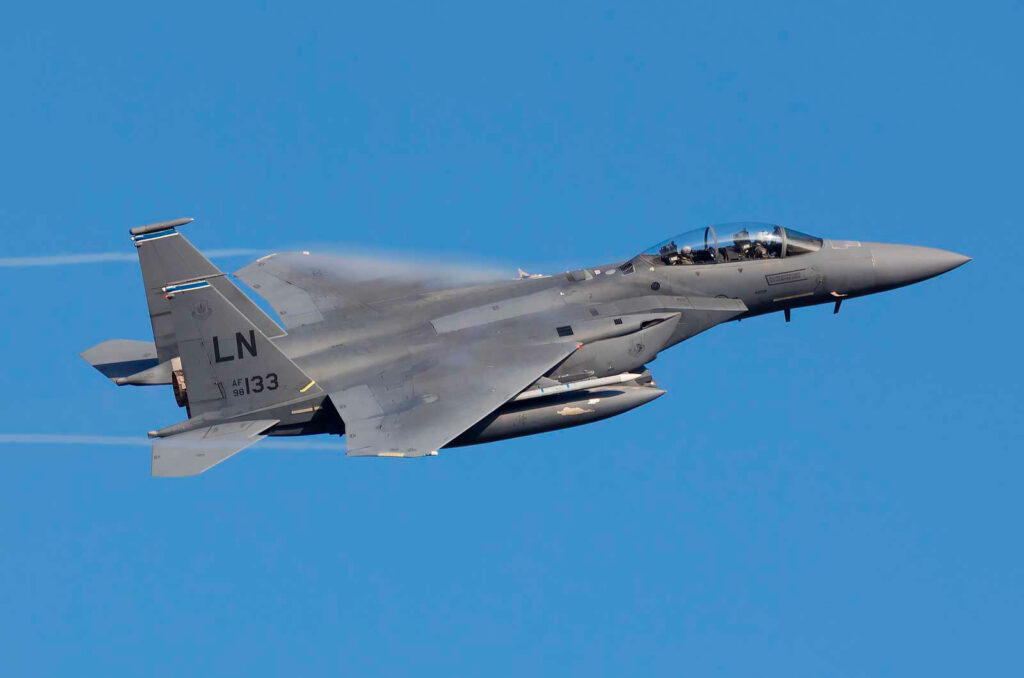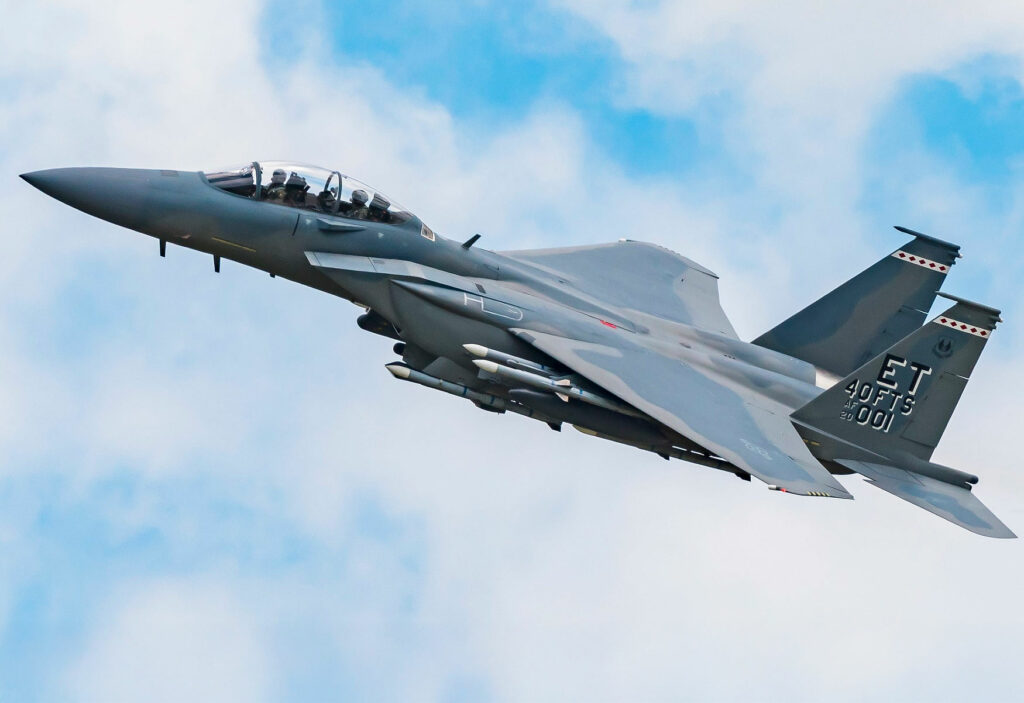The Boeing F-15EX Eagle is a modernized multirole fighter jet, enhancing payload, range, and avionics over previous F-15 models.
The Boeing F-15EX Eagle is an advanced iteration of the F-15 series, designed to replace aging F-15C/D models in the U.S. Air Force. It features enhanced avionics, including a digital fly-by-wire system, a new electronic warfare suite, and the AN/APG-82(V)1 Active Electronically Scanned Array (AESA) radar. Powered by two Pratt & Whitney F100-PW-229 afterburning turbofan engines, each producing up to 29,000 pounds (129 kN) of thrust, the F-15EX achieves speeds exceeding Mach 2.5. It boasts a maximum takeoff weight of 81,000 pounds (36,741 kg) and can carry a diverse array of weapons across its 12 external hardpoints. With an operational range of approximately 1,200 nautical miles (2,222 km) and a combat radius of 1,100 nautical miles (2,040 km), the F-15EX offers significant improvements in payload capacity, survivability, and mission flexibility compared to its predecessors.
History of the Development of the Boeing F-15EX Eagle II
In the late 1960s, the United States sought to develop a new air superiority fighter to counter emerging threats from advanced Soviet aircraft. This initiative led to the creation of the McDonnell Douglas F-15 Eagle, which first flew in 1972 and entered service in 1976. The F-15 was renowned for its exceptional speed, agility, and combat effectiveness, achieving an unparalleled air-to-air combat record.
As the decades progressed, the F-15 underwent several upgrades to enhance its capabilities. The F-15E Strike Eagle variant, introduced in the late 1980s, added multirole capabilities, enabling both air-to-air and air-to-ground missions. Despite these advancements, by the early 2000s, the U.S. Air Force recognized the need to modernize its aging fleet of F-15C/D aircraft, which were approaching the end of their service lives.
In response, Boeing proposed the F-15X, later designated as the F-15EX Eagle II, as a cost-effective solution to replace the older F-15 models. The F-15EX program aimed to leverage the existing F-15 airframe while integrating advanced technologies to meet contemporary combat requirements. This approach promised reduced development time and costs compared to designing an entirely new aircraft.
The U.S. Department of Defense initiated the F-15EX program to rapidly field a modernized fighter capable of carrying advanced weaponry and operating in contested environments. The F-15EX was designed to complement fifth-generation fighters like the F-22 Raptor and F-35 Lightning II, providing a high-capacity weapons platform with proven reliability.
The F-15EX incorporates several key enhancements over its predecessors. It features a digital fly-by-wire flight control system, replacing the traditional mechanical controls, which improves handling and allows for future upgrades. The aircraft is equipped with the AN/APG-82(V)1 AESA radar, providing superior detection and tracking capabilities. Additionally, the Eagle Passive/Active Warning and Survivability System (EPAWSS) enhances the aircraft’s electronic warfare capabilities, improving survivability in hostile environments.
The F-15EX also boasts an increased payload capacity, with the ability to carry up to 22 air-to-air missiles or a variety of air-to-ground munitions across its 12 external hardpoints. This versatility enables the aircraft to perform a wide range of missions, from air superiority to deep strike operations.
The first F-15EX conducted its maiden flight on February 2, 2021. Subsequently, the U.S. Air Force took delivery of the first operational F-15EX in March 2021, marking the beginning of a planned acquisition of at least 144 aircraft to replace the aging F-15C/D fleet. The F-15EX was officially named “Eagle II” during a ceremony at Eglin Air Force Base in April 2021.
The development of the F-15EX reflects a strategic decision to balance the introduction of advanced fifth-generation fighters with the modernization of proven fourth-generation platforms. This approach ensures the U.S. Air Force maintains a robust and flexible fighter fleet capable of addressing a diverse array of threats in an evolving global security environment.

Design of the Boeing F-15EX Eagle II
The Boeing F-15EX Eagle II retains the classic design elements of the F-15 series while incorporating significant advancements to meet modern combat requirements.
Airframe and Structure:
The F-15EX features a twin-engine, twin-tail configuration with a high-mounted swept wing design. The airframe is constructed primarily of aluminum alloys, with titanium and composite materials used in critical areas to enhance strength and reduce weight. The aircraft’s dimensions include a length of 63.8 feet (19.45 meters), a wingspan of 42.8 feet (13.05 meters), and a height of 18.5 feet (5.63 meters). The wing area measures 608 square feet (56.5 square meters), providing excellent lift and maneuverability.
Avionics and Systems:
A key advancement in the F-15EX is its digital fly-by-wire flight control system, replacing the mechanical controls of earlier models. This system enhances aircraft handling, stability, and allows for future software upgrades. The cockpit is equipped with advanced avionics, including large-area multifunction displays (LAD), a wide-angle head-up display (HUD), and a Joint Helmet-Mounted Cueing System (JHMCS) for superior situational awareness.
Radar and Sensors:
The F-15EX features the AN/APG-82(V)1 AESA radar, which provides enhanced detection, tracking, and target engagement capabilities. This radar can simultaneously track multiple targets in air and ground domains. Additionally, the aircraft is equipped with the Eagle Passive/Active Warning and Survivability System (EPAWSS), which delivers advanced electronic warfare capabilities, including threat detection and countermeasures.
Weapons Payload:
The F-15EX is designed to carry up to 29,500 pounds (13,381 kg) of weapons, including 12 external hardpoints and the ability to mount future weapons systems. Its weapons payload includes air-to-air missiles like the AIM-120 AMRAAM and AIM-9X Sidewinder, as well as air-to-ground munitions such as the Joint Direct Attack Munition (JDAM), Small Diameter Bomb (SDB), and AGM-88 HARM missiles. This versatility ensures compatibility with existing and emerging weapons.
Strengths and Limitations:
The F-15EX offers unmatched payload capacity and advanced systems while retaining the speed and agility characteristic of the F-15 series. Its design emphasizes modularity, enabling rapid upgrades to avionics and weapons. However, as a fourth-generation aircraft, it lacks the stealth characteristics of newer fifth-generation fighters, making it more detectable in highly contested environments.
Performance of the Boeing F-15EX Eagle II
Speed and Altitude:
The F-15EX is powered by two Pratt & Whitney F100-PW-229 afterburning turbofan engines, each producing up to 29,000 pounds (129 kN) of thrust. This allows the aircraft to achieve a top speed exceeding Mach 2.5, or roughly 1,900 mph (3,058 km/h). It can operate at altitudes of up to 65,000 feet (19,812 meters), providing a significant advantage in high-altitude engagements.
Range and Endurance:
The aircraft has an operational range of 1,200 nautical miles (2,222 kilometers) and a combat radius of 1,100 nautical miles (2,040 kilometers) with full armament. With external fuel tanks, the range extends further, supporting long-range strike and patrol missions. The F-15EX’s in-flight refueling capability ensures extended operational endurance.
Weapons Capabilities:
The F-15EX’s ability to carry diverse weapon systems is one of its strongest attributes. Its 12 external hardpoints accommodate a mix of air-to-air and air-to-ground munitions, making it suitable for various mission types, including air superiority, strike, and suppression of enemy air defenses (SEAD).
Comparison to Competitors:
Compared to fifth-generation aircraft like the F-35 Lightning II, the F-15EX lacks stealth capabilities but compensates with greater speed, payload, and lower operational costs. Against fourth-generation rivals like the Eurofighter Typhoon or Dassault Rafale, the F-15EX’s advanced radar, electronic warfare systems, and payload capacity provide a competitive edge.
Maneuverability and Agility:
The F-15EX retains the agility of its predecessors, capable of performing complex maneuvers at high speeds and altitudes. Its twin-tail design and powerful engines ensure excellent thrust-to-weight ratio and stability during combat.
Variants of the Boeing F-15EX Eagle II
The F-15EX program currently focuses on a standardized model for the U.S. Air Force. However, potential variants and export adaptations could emerge:
- Standard F-15EX:
This variant is optimized for U.S. Air Force requirements, featuring advanced avionics, weapons systems, and modular design for future upgrades. - F-15QA:
While not officially part of the F-15EX line, the F-15QA (developed for Qatar) shares many advanced features with the F-15EX, including AESA radar and digital fly-by-wire systems. - Export Variant:
A proposed export version could include tailored systems and reduced capabilities to comply with international arms regulations while meeting the needs of allied nations.
The modular design of the F-15EX ensures adaptability for different mission profiles and future technological advancements.

Military Use and Combat of the Boeing F-15EX Eagle II
Operational Role:
The F-15EX is primarily designed for air superiority, strike missions, and SEAD roles. Its advanced avionics and weapons payload enable it to operate effectively in contested environments, supporting both offensive and defensive operations.
Armament:
The F-15EX’s weapons suite includes a mix of air-to-air and air-to-ground munitions. Key systems include:
- AIM-120 AMRAAM and AIM-9X Sidewinder missiles for air combat.
- JDAM and SDB for precision strikes.
- AGM-88 HARM for targeting enemy radar systems.
- Compatibility with hypersonic missiles, positioning the aircraft for next-generation warfare.
Combat Experience:
As a newly introduced aircraft, the F-15EX has not yet seen combat. However, its predecessor, the F-15E Strike Eagle, has an extensive combat record, including operations in the Gulf War, Iraq, Afghanistan, and Syria. The F-15EX builds on this legacy with improved survivability, range, and payload.
Potential Export and Competitors:
While the F-15EX is designed primarily for the U.S. Air Force, it may attract interest from nations operating older F-15 models. Potential buyers include Japan, Saudi Arabia, and Israel. Competing platforms include the Eurofighter Typhoon, Dassault Rafale, and Su-35 Flanker-E, each with strengths and weaknesses compared to the F-15EX.
Current Status and Future Prospects:
The U.S. Air Force plans to acquire at least 144 F-15EX aircraft, with options for additional units. This acquisition ensures the F-15EX remains a cornerstone of the tactical fighter fleet through the 2040s. The aircraft’s modular design allows for continued upgrades, ensuring relevance in evolving combat scenarios.
The Boeing F-15EX Eagle II combines the proven capabilities of the F-15 series with modernized systems to meet contemporary combat requirements. Its high payload capacity, advanced radar, and modular design ensure flexibility across a wide range of missions. While it lacks the stealth of fifth-generation fighters, the F-15EX compensates with unmatched versatility, operational range, and cost-effectiveness, making it a critical asset for the U.S. Air Force and potential allied operators.
Back to the Fighter Jet section.